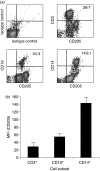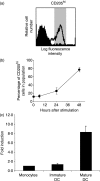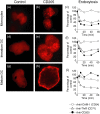Altered expression and endocytic function of CD205 in human dendritic cells, and detection of a CD205-DCL-1 fusion protein upon dendritic cell maturation
- PMID: 17163964
- PMCID: PMC2265885
- DOI: 10.1111/j.1365-2567.2006.02512.x
Altered expression and endocytic function of CD205 in human dendritic cells, and detection of a CD205-DCL-1 fusion protein upon dendritic cell maturation
Abstract
CD205 (DEC-205) is a member of the macrophage mannose receptor family of C-type lectins. These molecules are known to mediate a wide variety of biological functions including the capture and internalization of ligands for subsequent processing and presentation by dendritic cells. Although its ligands await identification, the endocytic properties of CD205 make it an ideal target for those wishing to design vaccines and targeted immunotherapies. We present a detailed analysis of CD205 expression, distribution and endocytosis in human monocyte-derived dendritic cells undergoing lipopolysaccharide-induced maturation. Unlike other members of the macrophage mannose receptor family, CD205 was up-regulated upon dendritic cell maturation. This increase was a result of de novo synthesis as well as a redistribution of molecules from endocytic compartments to the cell surface. Furthermore, the endocytic capacity of CD205 was abrogated and small amounts of the recently identified CD205-DCL-1 fusion protein were detected in mature DC. Our results suggest that CD205 has two distinct functions -- one as an endocytic receptor on immature dendritic cells and a second as a non-endocytic molecule on mature dendritic cells -- and further highlight its potential as an immuno-modulatory target for vaccine and immunotherapy development.
Figures






Similar articles
-
Expression of human DEC-205 (CD205) multilectin receptor on leukocytes.Int Immunol. 2006 Jun;18(6):857-69. doi: 10.1093/intimm/dxl022. Epub 2006 Mar 31. Int Immunol. 2006. PMID: 16581822
-
C-reactive protein impairs human CD14+ monocyte-derived dendritic cell differentiation, maturation and function.Eur J Immunol. 2006 Nov;36(11):2993-3006. doi: 10.1002/eji.200635207. Eur J Immunol. 2006. PMID: 17051617
-
CD205 (DEC-205): a recognition receptor for apoptotic and necrotic self.Mol Immunol. 2009 Mar;46(6):1229-39. doi: 10.1016/j.molimm.2008.11.016. Epub 2009 Jan 8. Mol Immunol. 2009. PMID: 19135256 Free PMC article.
-
Tolerogenic dendritic cells.Annu Rev Immunol. 2003;21:685-711. doi: 10.1146/annurev.immunol.21.120601.141040. Epub 2001 Dec 19. Annu Rev Immunol. 2003. PMID: 12615891 Review.
-
Dual function of C-type lectin-like receptors in the immune system.Curr Opin Cell Biol. 2003 Oct;15(5):539-46. doi: 10.1016/j.ceb.2003.08.004. Curr Opin Cell Biol. 2003. PMID: 14519388 Review.
Cited by
-
Expression, Distribution, and Role of C-Type Lectin Receptors in the Human and Animal Middle Ear and Eustachian Tube: A Review.Molecules. 2018 Mar 22;23(4):734. doi: 10.3390/molecules23040734. Molecules. 2018. PMID: 29565818 Free PMC article. Review.
-
Glycan-binding profile of DC-like cells.Glycoconj J. 2020 Feb;37(1):129-138. doi: 10.1007/s10719-019-09897-9. Epub 2019 Dec 13. Glycoconj J. 2020. PMID: 31834559
-
An approach for developing a blood-based screening panel for lung cancer based on clonal hematopoietic mutations.PLoS One. 2024 Aug 22;19(8):e0307232. doi: 10.1371/journal.pone.0307232. eCollection 2024. PLoS One. 2024. PMID: 39172974 Free PMC article.
-
Stories From the Dendritic Cell Guardhouse.Front Immunol. 2019 Dec 11;10:2880. doi: 10.3389/fimmu.2019.02880. eCollection 2019. Front Immunol. 2019. PMID: 31921144 Free PMC article. Review.
-
Localization of sporadic neuroendocrine tumors by gene expression analysis of their metastases.Clin Exp Metastasis. 2011 Oct;28(7):637-47. doi: 10.1007/s10585-011-9397-5. Epub 2011 Jun 17. Clin Exp Metastasis. 2011. PMID: 21681495
References
-
- Stahl PD, Ezekowitz RA. The mannose receptor is a pattern recognition receptor involved in host defense. Curr Opin Immunol. 1998;10:50–5. - PubMed
-
- Figdor CG, van Kooyk Y, Adema GJ. C-type lectin receptors on dendritic cells and Langerhans cells. Nat Rev Immunol. 2002;2:77–84. - PubMed
-
- Jiang W, Swiggard WJ, Heufler C, Peng M, Mirza A, Steinman RM, Nussenzweig MC. The receptor DEC-205 expressed by dendritic cells and thymic epithelial cells is involved in antigen processing. Nature. 1995;375:151–5. - PubMed
-
- McKay PF, Imami N, Johns M, et al. The gp200-MR6 molecule which is functionally associated with the IL-4 receptor modulates B cell phenotype and is a novel member of the human macrophage mannose receptor family. Eur J Immunol. 1998;28:4071–83. - PubMed
-
- Kato M, Neil TK, Clark GJ, Morris CM, Sorg RV, Hart DN. cDNA cloning of human DEC-205, a putative antigen-uptake receptor on dendritic cells. Immunogenetics. 1998;47:442–50. - PubMed
Publication types
MeSH terms
Substances
LinkOut - more resources
Full Text Sources
Other Literature Sources
Molecular Biology Databases
Research Materials

